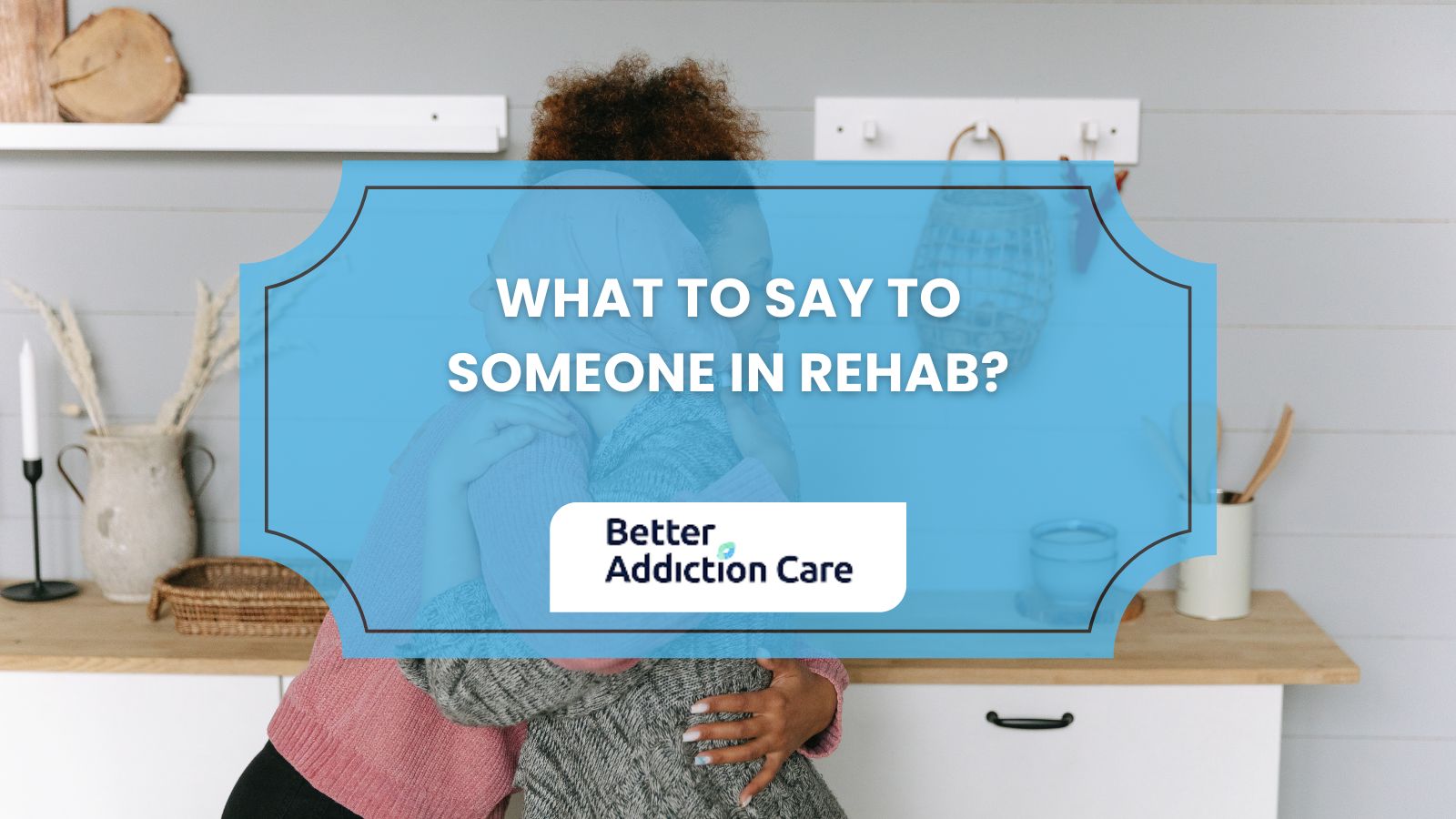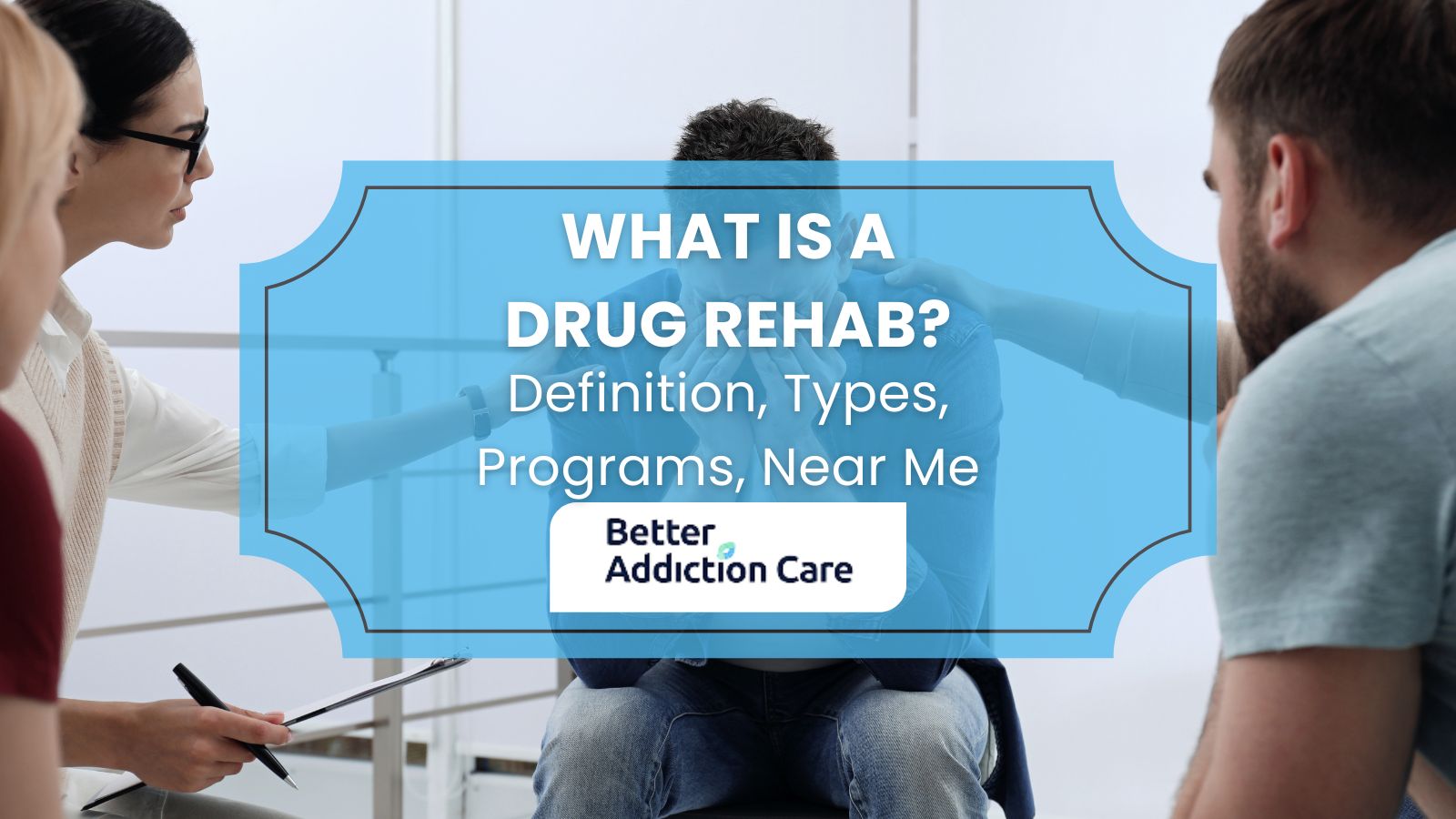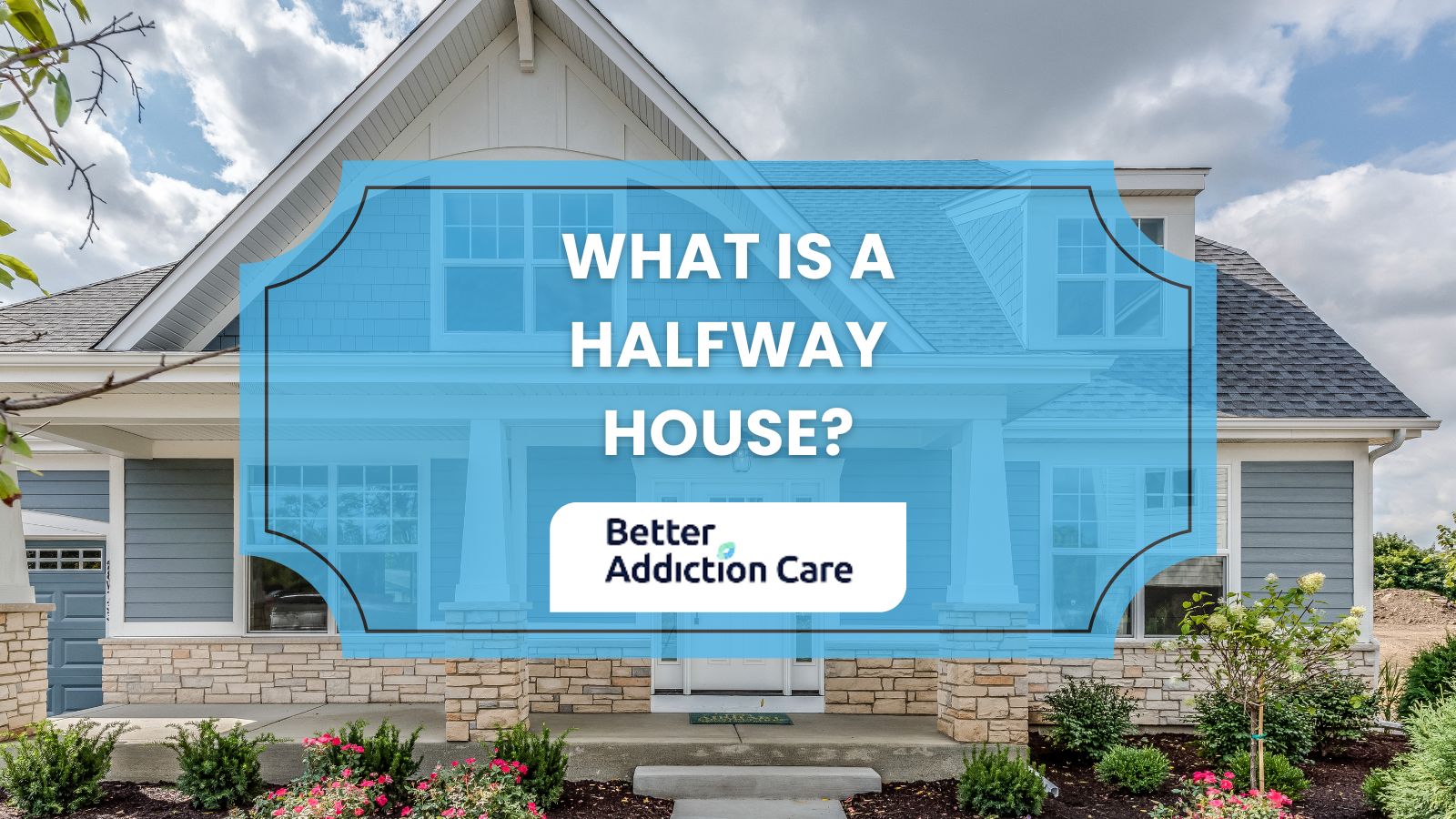Sober Living Homes: How It Works, Eligibility, How To Choose, Benefits and Limitations
Sober living homes provide a safe living environment for individuals in addiction recovery, offering structured housing as a transitional step between rehab and independent living. These residences, also known as halfway houses or recovery homes, support sobriety by enforcing sober living home rules such as drug testing, curfews, and participation in support groups. Studies show that sober living homes improve long-term recovery outcomes by reducing relapse rates and increasing social stability.

Sober living homes work by providing a structured setting where residents follow sober living home rules, including abstaining from drugs and alcohol, attending therapy, and contributing to household responsibilities. Unlike inpatient rehab, residents work, attend school, and gradually reintegrate into daily life while receiving peer and professional support. According to Polcin and Korcha (2017) in the study "Housing Status, Psychiatric Symptoms, and Substance Abuse Outcomes Among Sober Living House Residents over 18 Months," individuals in sober living homes showed improved housing stability and psychiatric well-being, both of which contributed to better substance abuse outcomes.
Individuals eligible for sober living homes include those in addiction recovery who have completed rehab or need a transitional environment to maintain sobriety. Applicants must agree to house rules, actively participate in support groups, and demonstrate a commitment to recovery.
What Is a Sober Living Home?
A sober living home is a drug- and alcohol-free residence that provides a safe living environment for individuals in addiction recovery, offering a structured setting that supports sobriety as a transitional step between rehab and independent living. These residences, also known as halfway houses or recovery homes, enforce house rules such as mandatory drug testing, curfews, and participation in support groups to help individuals maintain long-term recovery. Residents live in a peer-supported community where they gradually reintegrate into daily life while continuing therapy and employment. Studies show that individuals in sober living homes experience lower relapse rates and improved social stability, as noted by Polcin et al. (2010) in the study "The Role of Sober Living Houses in Promoting Long-Term Addiction Recovery."
How Are Sober Living Homes Regulated?
Sober living homes, also known as halfway houses, provide individuals in addiction recovery with a safe living environment that is both structured and transitional. These residences serve as a bridge between intensive treatment programs and independent living, offering a supportive community that promotes sobriety and personal responsibility. According to Polcin and Korcha in the study "Housing Status, Psychiatric Symptoms, and Substance Abuse Outcomes Among Sober Living House Residents Over 18 Months" (2017), individuals in sober living homes showed improved housing stability, with stable housing increasing from 13% to 27% over 18 months.
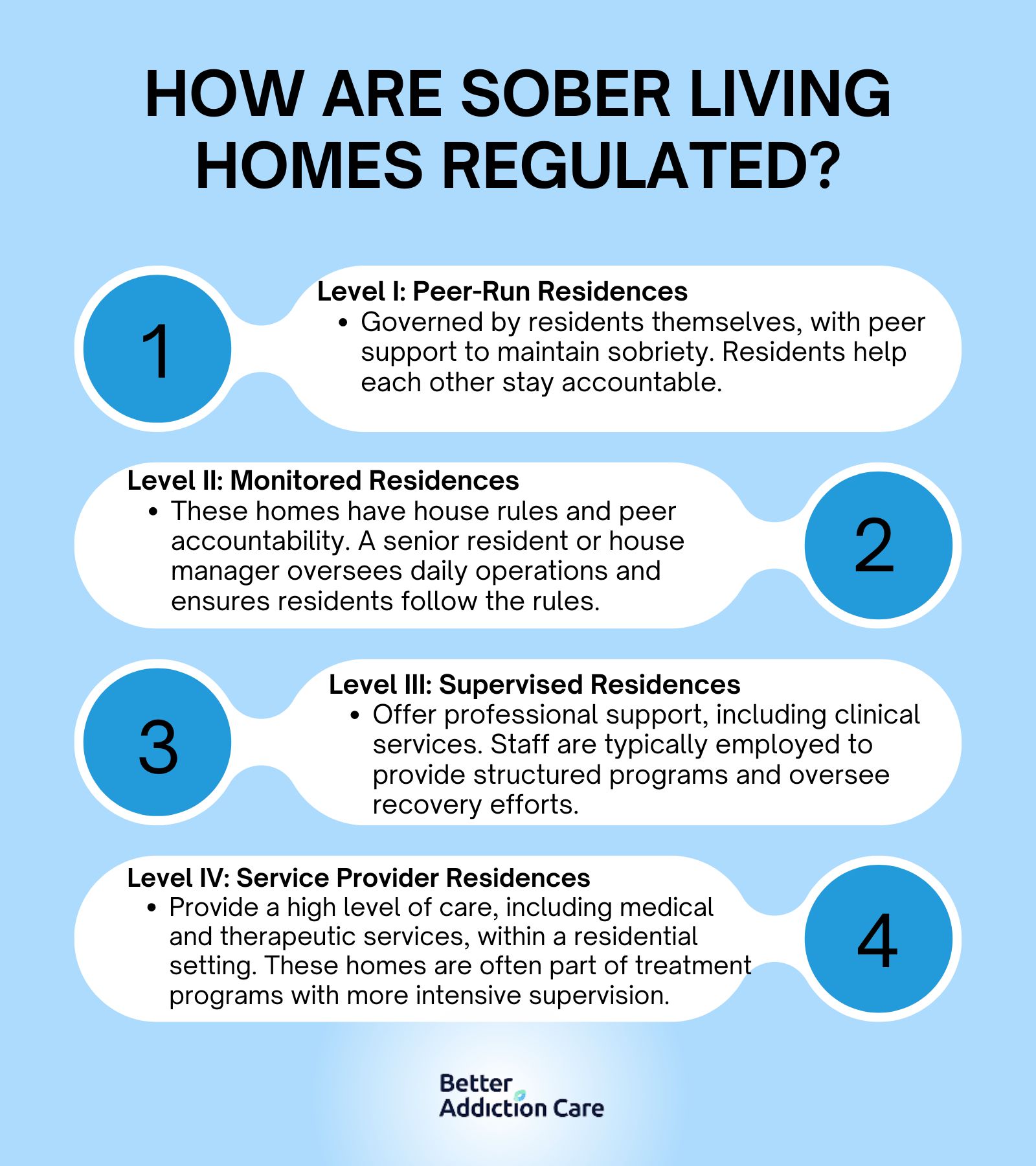
The operation of sober living homes varies across different levels of support. According to the National Alliance for Recovery Residences (NARR), there are four distinct levels:
-
Level I: Peer-Run Residences: These are democratically governed homes where residents support each other in maintaining sobriety.
-
Level II: Monitored Residences: Referred to as sober homes or sober living environments, these residences have house rules and peer accountability, with a senior resident or house manager overseeing operations.
-
Level III: Supervised Residences: These facilities offer professional support and include clinical services. They are typically overseen by paid staff and provide structured programs to aid recovery.
-
Level IV: Service Provider Residences: These are residential treatment programs that offer a high level of care, including medical and therapeutic services, within a residential setting.
How Do Sober Living Homes Work?
Sober living homes work by providing structured, substance-free housing that supports individuals in addiction recovery as they transition from rehab to independent living. These residences operate at different levels based on the services provided and the structure of the environment. According to the National Alliance for Recovery Residences (NARR), there are four levels of sober living homes.
Daily operations in sober living homes include house meetings, group therapy, and participation in 12-step or alternative recovery programs. Staff roles vary by level, with higher levels involving licensed counselors, case managers, and recovery coaches. These homes foster accountability through curfews, substance testing, and structured routines that encourage long-term sobriety.
Our drug rehab locator also helps you find structured sober living homes across California, Illinois, Texas, New York, Florida, Massachusetts, Oklahoma, Georgia, and Pennsylvania. Search by location to discover NARR-certified recovery residences that offer the right level of support for your transition from rehab to independent living, with options ranging from peer-run environments to professionally staffed facilities.
What Are the Rules of Sober Living Homes?
Common rules in sober living homes include maintaining a substance-free environment, adhering to curfews, participating in house meetings or support groups, and contributing to household responsibilities. These rules foster accountability and encourage active participation in the recovery process.
Rules of sober living homes are listed below:
-
Sobriety Requirement: Residents must remain completely free from drugs and alcohol. Regular and random drug testing ensures compliance and helps prevent relapse, creating a safe and supportive environment for all residents.
-
Curfews: Residents must adhere to set curfews to promote structure and discourage late-night activities that could lead to substance use. This rule fosters discipline, accountability, and stability in daily routines.
-
Mandatory House Meetings: Weekly or daily meetings provide residents with a space to discuss challenges, set recovery goals, and support one another. These meetings reinforce accountability and peer encouragement.
-
Participation in Support Groups: Residents must attend recovery meetings such as 12-step programs, SMART Recovery, or other structured group therapy sessions. Support groups help individuals build a network of sober peers and maintain motivation for long-term recovery.
-
Employment or Productive Activities: Many homes require residents to work, attend school, or engage in volunteer activities. Maintaining responsibilities prevents idleness, builds self-sufficiency, and reintegrates individuals into society.
-
Household Chores: Residents must contribute to keeping the home clean and functional by completing assigned chores. Shared responsibilities encourage cooperation, discipline, and a sense of community.
-
No Violence or Disruptive Behavior: Physical aggression, verbal abuse, or any form of intimidation is strictly prohibited. A peaceful and respectful environment is necessary for emotional well-being and long-term sobriety.
-
Visitor Restrictions: Many sober living homes limit visitors or require approval for guests. These rules prevent exposure to potential triggers and help maintain a stable recovery environment.
-
Medication Management: Prescription medications must be taken as directed, and some homes require staff supervision for controlled substances. This prevents misuse and ensures that medications support, rather than hinder recovery.
-
Compliance with House Rules and Consequences: Violating house rules result in consequences ranging from warnings to expulsion. Clear consequences help reinforce the importance of personal responsibility and commitment to recovery.
What Is the Daily Routine in a Sober Living Home?
The daily routine in a sober living home includes chores, therapy, and meetings to maintain a structured environment. Residents begin their day with household responsibilities, fostering accountability and a sense of community. Therapy sessions, both individual and group, address personal challenges and support emotional well-being. Support group meetings, such as 12-step programs, provide peer encouragement and reinforce commitment to sobriety. A well-structured daily schedule helps residents build healthy habits for long-term recovery.
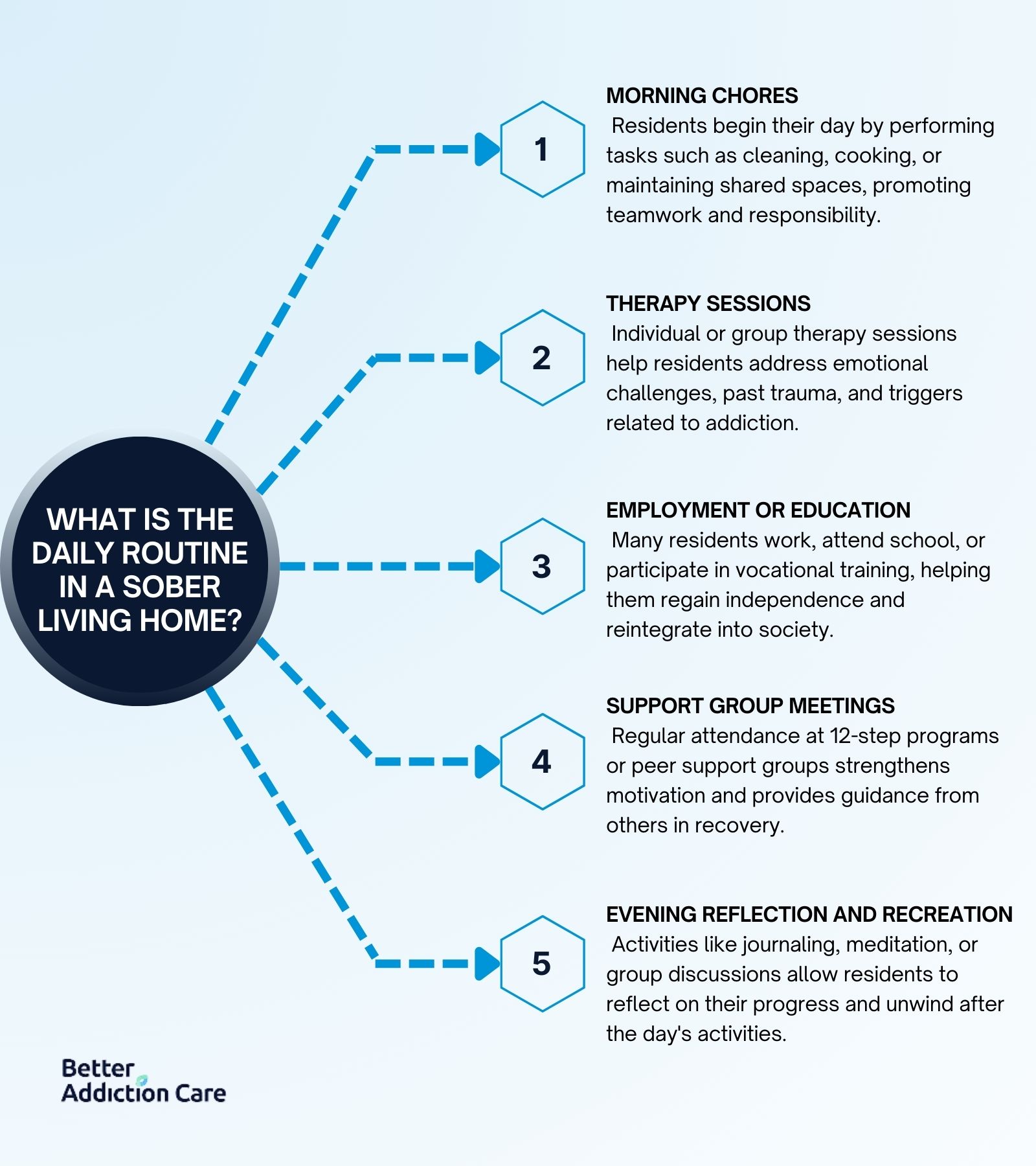
The key activities in a sober living home are listed below:
-
Morning Chores: Residents start the day with tasks like cleaning, cooking, or maintaining shared spaces, reinforcing responsibility and teamwork.
-
Therapy Sessions: Individual or group therapy helps address past trauma, triggers, and emotional challenges tied to addiction recovery.
-
Employment or Education: Many residents work, attend school, or participate in vocational training to support independence and reintegration into society.
-
Support Group Meetings: Regular attendance at 12-step programs or peer support groups strengthens motivation and provides guidance from others in recovery.
-
Evening Reflection and Recreation: Relaxing activities like journaling, meditation, or group discussions help residents unwind and process their progress.
What Are the Eligibility Requirements for Sober Living?
The eligibility requirements for sober living homes include completing a detox or rehab program, committing to sobriety, following house rules, and paying housing fees. These requirements ensure that residents are prepared for a structured, substance-free environment that promotes recovery. Meeting these criteria helps individuals transition from treatment to independent living while maintaining their sobriety.
Eligibility requirements for sober living homes vary but generally include:
-
Completion of a detox or rehabilitation program: Most sober living homes require residents to have completed a formal drug detox or rehab program. This ensures that individuals enter the home with a foundation for recovery and are physically stable enough to engage in daily activities.
-
Commitment to sobriety: Residents must agree to remain substance-free and actively work toward their recovery goals. Many homes enforce this commitment through regular drug testing and participation in support groups like 12-step programs.
-
Ability to pay fees: While some sober living homes offer financial assistance or sliding-scale fees, most require residents to contribute to housing costs. This financial responsibility fosters independence and prepares individuals for self-sufficiency after leaving the program.
-
Compliance with house rules: Residents must follow structured guidelines, such as curfews, mandatory house meetings, and participation in household chores. These rules help maintain order, encourage accountability, and create a safe environment for everyone in recovery.
What Types of Recovery Programs Are Offered in Sober Living Homes?
The types of recovery programs offered in sober living homes include 12-step meetings, peer support groups, and alternative therapeutic approaches designed to maintain sobriety and foster long-term recovery. These substance abuse recovery programs provide structured support, accountability, and skill-building opportunities to help residents transition to independent living. Studies show that individuals engaged in structured recovery programs experience improved treatment retention and lower relapse rates.
Sober living homes offer various recovery programs to support residents, including:
-
Increased treatment engagement: Peer support groups encourage participation in addiction recovery programs, increasing retention rates in treatment. According to Tracy and Wallace (2016) in the study "Benefits of Peer Support Groups in the Treatment of Addiction," individuals involved in peer-led recovery groups show higher engagement in long-term treatment plans.
-
Reduced substance use and cravings: Participating in peer support groups has been linked to lower substance use and fewer cravings. Studies show that structured group settings help individuals develop coping strategies that minimize relapse risk as noted by Tracy and Wallace (2016) in "Benefits of Peer Support Groups in the Treatment of Addiction."
-
Emotional and social support: Peer groups provide a sense of belonging and shared understanding that reduces feelings of isolation. Al-Anon has demonstrated the value of peer-led support in helping individuals affected by addiction build resilience and improve mental health, as noted by Cermak (1989) in "Al-Anon and Recovery."
-
Improved self-efficacy and accountability: Regular attendance in peer-led groups fosters a sense of personal responsibility and self-confidence in maintaining sobriety. Support from peers reinforces healthy decision-making and relapse prevention strategies, according to Tracy and Wallace (2016) in "Benefits of Peer Support Groups in the Treatment of Addiction."
Can You Visit Someone in a Sober Living Home?
Yes, you can visit someone in a sober living home. Visitation policies vary by facility but include specific visiting hours and guidelines to ensure a supportive environment for all residents. It's advisable to contact the specific home to understand their visitation rules and schedule visits accordingly.
How Do You Get Into a Sober Living Home?
The admission process for a sober living home involves several steps to ensure suitability and commitment to recovery.
Steps to get into a sober living home are listed below:
-
Research and Application: Prospective residents begin by identifying suitable sober living homes that align with their recovery goals. This involves researching various facilities, understanding their rules, and ensuring they offer a supportive environment conducive to sobriety.
-
Interview Process: After submitting an application, candidates undergo an interview to assess their readiness and commitment to maintaining a substance-free lifestyle. This step ensures that the individual is a good fit for the community and is dedicated to their recovery journey.
-
Acceptance and Orientation: Once accepted, new residents receive an orientation detailing the house rules, expectations, and responsibilities. This includes understanding chores, meeting attendance, and participation in house activities, all designed to promote accountability and structure.
How Long Can You Stay in a Sober Living Home?
The duration of stay in a sober living home varies based on individual needs and progress in recovery. Residents typically stay for several months to over a year, allowing ample time to establish stability and coping mechanisms. Factors influencing the length of stay include personal recovery progress, employment status, and readiness to transition to independent living. Extended stays are encouraged to reinforce sobriety and reduce the risk of relapse.
What Are the Benefits of Sober Living Homes?
Sober living homes offer benefits that provide a safe living environment and peer support, which are important for maintaining sobriety. Residents experience reduced relapse rates due to the accountability and support systems in place. For example, studies have shown that individuals in sober living homes have higher abstinence rates compared to those who do not utilize such services. The first few weeks are especially critical, as residents who stay at least six weeks have a significantly lower risk of leaving prematurely, as noted by Jason et al. (2023) in the study "Understanding Length of Stay in Recovery Homes." Additionally, the structured daily routines and responsibilities help residents develop life skills essential for independent living. The combination of these factors creates a supportive community that fosters long-term recovery.
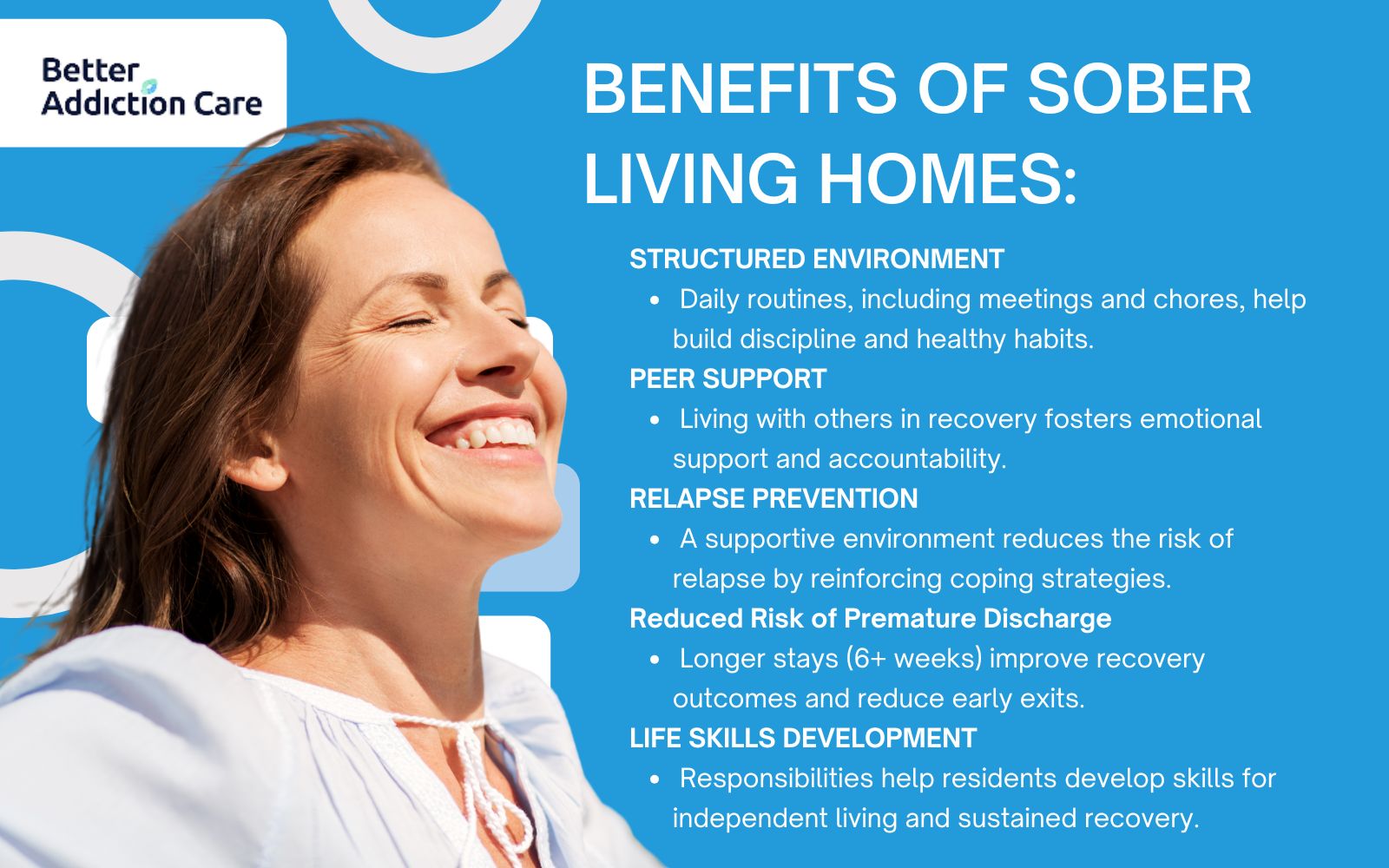
The key benefits of sober living homes are highlighted below:
-
Structured Environment: Sober living homes provide daily routines that include scheduled meetings, assigned chores, and required therapy sessions. This structure helps individuals develop discipline and reinforces healthy habits that support long-term sobriety.
-
Peer Support: Living in a community with others in recovery fosters emotional support, encouragement, and shared experiences. Peer relationships help residents stay motivated and hold each other accountable.
-
Relapse Prevention: The supportive environment in sober living homes reduces the likelihood of relapse. According to Larimer et al. (2000) in the study "Relapse Prevention: An Overview of Marlatt’s Cognitive-Behavioral Model," effective relapse prevention strategies involve identifying high-risk situations, developing coping skills, and restructuring perceptions of the relapse process, all of which are reinforced in sober living environments.
What Are the Limitations of Sober Living Homes?
The main limitation of sober living homes is the risk of relapse among residents, which negatively impacts the recovery atmosphere for others. Additionally, the costs associated with sober living homes are a financial burden, and the communal living environment leads to interpersonal conflicts. These limitations highlight the importance of choosing the right home and understanding the responsibilities involved.
Common limitations of sober living homes include:
-
Potential for Relapse: The risk of relapse among residents creates challenges for others in the home. If one resident struggles with maintaining sobriety, it affects the entire community.
-
Financial Costs: Sober living homes require residents to pay rent and cover expenses, which are affordable for everyone. Some homes offer financial assistance or sliding-scale fees, but costs still be a barrier.
-
Interpersonal Conflicts: Living with others in recovery leads to personality clashes, disagreements over chores, or challenges in maintaining a harmonious environment. Learning to manage these conflicts is an important part of the recovery process.
What Happens After Leaving a Sober Living Home?
After leaving a sober living home, individuals transition to independent living while continuing their aftercare plan to support long-term sobriety. This transition includes ongoing support through therapy, relapse prevention programs, and participation in recovery communities. Many individuals continue attending 12-step meetings, group counseling, or outpatient therapy to maintain their progress. Establishing a stable living environment, securing employment, and developing strong coping strategies further support success after leaving a sober living home.
How to Choose the Right Sober Living Home?
To choose the right sober living home requires researching a home that provides a stable and supportive environment that promotes sobriety. The checklist below outlines key factors to consider when selecting a sober living home:
-
Location: A home in a safe neighborhood near work, school, or support groups makes it easier to maintain stability in addiction recovery.
-
Cost: Monthly fees range from a few hundred to several thousand dollars, depending on location and services provided. Evaluating affordability and financial assistance options is important.
-
Services Offered: Homes that provide structured support, such as therapy, job assistance, or transportation, improve recovery outcomes.
-
Accreditation: Choosing a home that follows industry standards and is certified by organizations such as the National Alliance for Recovery Residences (NARR) ensures quality and safety.
In order to find rehabs that provide sober living services or have a comprehensive aftercare program that helps individuals transition from treatment to sober living.
How Much Does Sober Living Cost?
The cost of sober living varies based on location, services, and housing type. Standard sober living homes typically cost between $300 and $2,000 per month, with luxury homes charging more for additional amenities. Urban areas and homes that offer structured recovery programs have higher fees. Additional costs include therapy, transportation, and daily expenses.
Does Insurance Cover Sober Living Homes?
No, most insurance plans do not cover the costs associated with sober living homes. This is because these residences typically do not provide formal addiction treatment services. However, some policies offer partial coverage if the sober living arrangement is integrated into an outpatient program or formal addiction treatment.
Are There Any Alternatives for Sober Living?
Yes there are alternatives for sober living homes including halfway houses, transitional housing, recovery residences, and community-based support programs. These options provide varied support structures for individuals in addiction recovery, catering to different needs and preferences. Some alternatives focus on structured environments with peer accountability, while others offer flexible living arrangements with access to outpatient treatment.
Some of the notable alternatives include:
-
Outpatient Programs: These programs allow individuals to live at home while attending scheduled treatment sessions. They offer flexibility for those with work or family commitments and include counseling, education, and support groups.
-
Halfway Houses: Designed to assist individuals transitioning from incarceration or inpatient treatment back into society, halfway houses provide structured environments with rules and support systems to promote responsible living.
-
Oxford Houses: These are democratically run, self-supporting recovery houses. Residents share responsibilities and support each other's sobriety in a communal setting.
-
Transitional Housing: Aimed at helping individuals move from homelessness or treatment facilities to independent living, transitional housing offers temporary residence with support services to develop life skills and stability.
-
Community Support Groups: Organizations like Alcoholics Anonymous (AA) or Narcotics Anonymous (NA) provide peer support through regular meetings, fostering a sense of community and shared experience in recovery.
What Is the Difference Between a Halfway House and Sober Living?
The differences between halfway houses and sober living include entry requirements, length of stay, level of supervision, and funding sources. Halfway houses and sober living homes both support individuals in addiction recovery but differ in several key aspects.
Below is a comparison highlighting their distinctions:
|
Feature |
Halfway House |
Sober Living Home |
|
Purpose |
Primarily assist individuals transitioning from incarceration or inpatient treatment back into society. |
Provide a substance-free environment for individuals seeking to maintain sobriety after initial treatment. |
|
Eligibility |
Mandated for individuals exiting prison or court-ordered treatment programs. |
Open to individuals voluntarily seeking a supportive sober living environment. |
|
Regulation |
Subject to strict government regulations and oversight. |
Less regulated; standards vary by location and organization. |
|
Rules |
Structured schedules with mandatory programs and curfews. |
Residents adhere to house rules promoting sobriety and accountability but with more personal freedom. |
|
Duration of Stay |
Typically have a fixed length of stay,determined by legal or program requirements. |
Flexible length of stay, based on individual needs and progress in recovery. |
|
Programs Offered |
Focus on reintegration into society, including employment assistance and life skills training. |
Emphasize peer support, 12-step meetings, and building a sober lifestyle. |
|
Cost |
Generally funded by government or non-profit organizations; minimal cost to residents. |
Costs vary; residents usually pay rent and share living expenses. |
|
Focus |
Rehabilitation and reducing recidivism among former offenders. |
Maintaining sobriety and supporting ongoing recovery efforts. |
|
Examples of Residents |
Individuals transitioning from prison or court-mandated treatment programs. |
Persons seeking a supportive environment to continue their sobriety journey post-treatment. |
|
Environment |
More institutional with structured routines. |
Home-like setting promoting independence and peer support. |
What Is the Difference Between Inpatient Rehab and Sober Living?
The differences between inpatient rehabilitation (rehab) and sober living homes are significant in addiction recovery. Inpatient rehab offers intensive, structured treatment with 24/7 medical supervision, typically lasting 30 to 90 days. In contrast, sober living homes provide supportive, substance-free environments with peer accountability, allowing residents more freedom as they transition back to independent living. The duration of stay in sober living homes varies, extending beyond the limited time frame of inpatient rehab.
Are Sober Living Homes Suitable for Everyone?
No, sober living homes are not suitable for individuals who are unwilling to maintain abstinence from substances or those requiring intensive medical supervision. These environments are designed for residents committed to sobriety and participating in recovery programs. Individuals with severe medical or psychiatric conditions need more comprehensive care than sober living homes provide.
What Happens if You Relapse During Sober Living?
If you relapse during sober living, many homes have a zero-tolerance policy, leading to immediate discharge to protect the sobriety of other residents. Some facilities offer support and resources to help you return to recovery, depending on their specific policies. Relapse is a common challenge in addiction recovery, with research showing that 40% to 60% of individuals with substance use disorders experience a relapse at some point, according to Feltenstein et al. (Neural Substrates and Circuits of Drug Addiction, 2024).
Can You Work While Living in a Sober Living Home?
Yes, you can work while living in a sober living home, attend school, or participate in outpatient programs to promote responsibility and structure. Employment helps individuals reintegrate into society and supports financial independence during recovery.
Can You Have a Pet in Sober Living Homes?
Yes, some sober living homes allow pets with specific guidelines, such as requiring animals to be spayed or neutered, housebroken, and non-aggressive. Residents must manage their pets responsibly to ensure a safe environment for all.
Related Articles
Treatment Centers in Virginia




